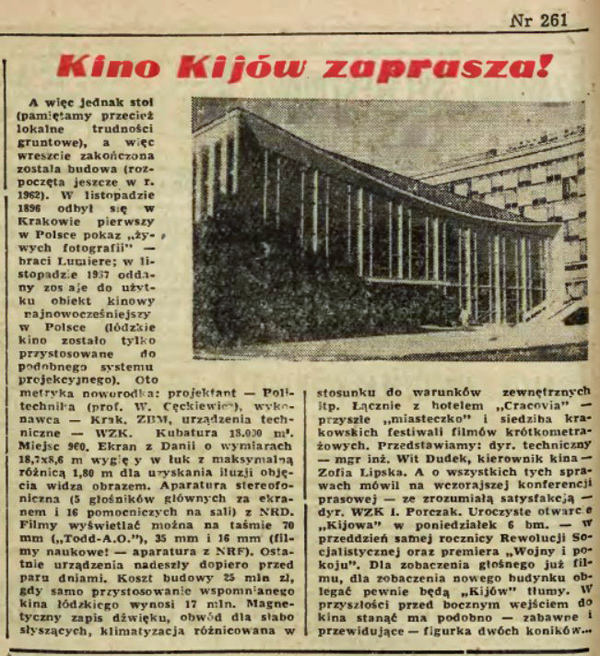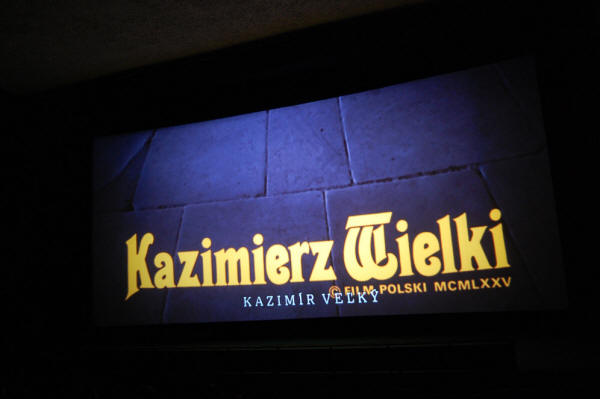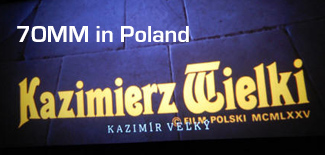Wide Format in Poland |
Read more at in70mm.com The 70mm Newsletter |
| Written by: Maciej Psyk. The author wishes to thank Krzysztof Gajdemski and Maciej Gil who maintain the website 70mm.lh2.pl for information available there. | Date: 20.06.2024 |
 “Nights and Days” (“Noce I Dnie”), Film Polski presentation,
1975. Directed by Jerzy Antczak starring Jadwiga Baranska and Jerzy
Binczycki. Photographed by Stanisław Loth with an ARRI II B in 35mm
anamorphic panorama format and blown up to 70mm. “Nights and Days” (“Noce I Dnie”), Film Polski presentation,
1975. Directed by Jerzy Antczak starring Jadwiga Baranska and Jerzy
Binczycki. Photographed by Stanisław Loth with an ARRI II B in 35mm
anamorphic panorama format and blown up to 70mm.In 1945 the entire Central-Eastern Europe fell into the sphere of influence of the victorious Soviet Union, and soon after found itself on the eastern side of the Iron Curtain. Until 1956 Stalinist brutality towards any independent thought meant death or imprisonment for many and carefully controlled spread of information for the masses. Certain things became taboo, first and foremost the 1940 Katyń massacre. Perhaps ironically, what was lost in the political oppression, the Communist regime intended to compensate in widely available and indeed promoted art: ballet, poetry, literature, popular and classic music and, of course, cinematography. There was a strong emphasis on organized viewing for the workforce from factories and soldiers from the barracks. If Fidel Castro could have said with pride that every Cuban prostitute has had a high school education, in the similar fashion the Communists could have said that every factory, steel mill worker or Private knew who Ingmar Bergman was. “Polish film school” was born and Polish movies were routinely being awarded accolades abroad. All things considered – as long as the director respected the taboos – it was a golden era for filmmaking and cinemas as its temples. This unique convergence of politics, ideology and emerging technologies had resulted in an impressive number of wide-format capable cinemas. All of them are history now, but proud and glorious history it was. List of Polish cinemas that in the past were capable of 70mm film projections: • Białystok ("Pokój"), • Częstochowa ("Wolność") • Gdańsk ("Znicz") • Kalisz ("Centrum") • Kalisz ("Kosmos") • Katowice ("Kosmos") • Katowice ("Rondo") • Kielce ("Moskwa") • Koszalin ("Adria") • Kraków ("Kijów") • Lublin ("Kosmos"), • Łódź ("Bałtyk") • Łódź ("Włókniarz") • Opole ("Kraków") • Poznań ("Apollo") • Słupsk ("Millennium") • Warszawa ("Oka") • Warszawa ("Relax") • Wrocław ("Gigant") • Wrocław ("Warszawa") • Go to Film 7OMM w Polsche, PDF from web site "70mm.lh2.pl" |
More in 70mm reading: 7OMM and Cinema Across the World Cinerama at The Camerimage Film Festival in Bydgoszcz, Poland “Nights and Days”: The North American 70mm Presentations Looking for DEFA 70 Stereo-70 Three-Dimensional Cinematography in Russia in70mm.com's Library Presented on the big screen in 7OMM Peripheral Vision, Scopes, Dimensions and Panoramas |
Description of Some Polish Cinemas |
|
|
“Millenium” in Słupsk A largest cinema in Pomerania region and continually in top 10 annual audience, it was built in 1959-1963 with the wide format screenings and stereophony in mind. That eventually happened in 1970 when the UP-700 Pyrkon projector was installed. It supplemented the existing 35mm projector AP-51 and other then-modern equipment. In 1972 "Tora Tora Tora" was screened in 70mm with coaches full of people from the entire northern Poland arriving to see it. The decline was noticeable from around 2000, and the demise in 2010 was gruesome: the building was sold out and re-opened as a discount supermarket. That is something despaired in Słupsk until today, because with a goodwill and vision there was a chance to at least save its cultural character (the podium was frequently used for theatre spectacles, piano concerts, stand-up comedy and public meetings). Mr. Paweł Wiliński was the cinema director from 1984 until its demise in 2010. Sadly, he passed away in 2015 and much of his knowledge about the wide film format disappeared with his passing. Useful link: • Local TV clip about Millenium • Press article • Best picture “Cosmos” in Lublin It had the same modernist building as its sister cinema “Millenium” in Słupsk with initially a whopping 800 seats, later scaled down to 678. Operating from 1961 until 2009. From 1970 was capable of 70mm projections on its panoramic screen with 6-channel audio. It was also one of the first with Dolby Digital sound. “Cosmos” proud itself for its technical team, which was capable of projecting films over 1000 times, some three time longer than the industry's standard. “Znicz” in Gdańsk “Znicz” was equipped with Pyrcon UP-700 with 4-channel audio for around a decade from 1975 to 1985. In 2000 the remaining apparature has been demolished. • Video of technician operating Pyrcon UP-700, around 1980 |
|
 1967,
Grand opening press announcement of the Kiyev cinema in Kraków 1967,
Grand opening press announcement of the Kiyev cinema in Kraków“Kiyev” in Kraków Built in 1967 from the ground-up as the pinnacle of present-day technology and a 70mm cinema, with its 960-seat it was meant to rival on equal foot flagship Western cinemas like Odeon Leicester Square and house international festivals. A hyper-futuristic curved screen 18.7 x 8.6m was purchased in Denmark. It had 5 main speakers behind the screen and 16 in the hall. It was the very first cinema capable of showing films in format 16, 35 and 70mm in Todd-AO. The very first movie was "War and Peace". In 1968 Kiyev screened "Those Magnificent Men in Their Flying Machines". “Relax” in Warsaw Located in the city centre and most modern and most popular cinema of its time in Poland, the Kino Relax was operating from 1970 to 2006. It housed an air-conditioned 650-seat cinema upstairs and a live theatre downstairs. Equipped for 70mm presentations, the screen was 19 meters wide. It was also home to the Warsaw Film Festival and many movie premieres. Stereo Sound appeared in 1979 for the Polish premiere of George Lucas’ “Star Wars”. In the years 1997-98, the cinema underwent modernization, received Dolby Digital Surround EX sound system & the largest pearl screen in the capital. “Matrix” and the “Pianist” were premiered here. Despite this, in 2006 “Relax” finally lost the competition with multiplexes. Useful link: • cinematreasures.org • beautifulwarszawa.home.blog “Oka” in Warsaw This was a special-purpose 350-seat cinema built for 3D projections in the Soviet Stereo-70 technology, to demonstrate its superiority over IMAX. The building was home to the Polish-Soviet Friendship Association. A must-see for Soviet Union citizens in Warsaw, over 11 years it had screened five Soviet 3D movies in the loop: • “Parade of Attractions”, 30 minutes, 1974, org. Parad attrakcyonow • “Playing Animals”, 30 minutes nature documentary, 1980, org. Igry żywotnych • “SOS Over Taiga”, thriller, 1976, org. S.O.S. nad Tajgoj • “Mysterious Monk”, action-adventure, 1968, org. Tainstwiennyj monach • “Rider on Golden Horse”, fantasy, 1980, org. Wsadnik na zołotom konie The movies required a special glasses (just like present-time 3D movies). System Stereo-70 was in use in the Soviet Union from 1966 until 1994. It is worth noting that although the technology did not survive, the movies had preceded “Avatar” by over 30 years. Useful link: ekartkazwarszawy.pl |
|
70mm Movies in Poland |
|
 German
advertisement for "Anne Karenina" in Sovscope 70 German
advertisement for "Anne Karenina" in Sovscope 70Some non-Polish 70mm movies had recevied a Polish dubbing. These were: • "Anna Karenina" / "Anna Karenina", director Aleksandr Zarchi, USSR 1967 • "Captain Florian of the Mill" / "Hauptmann Florian von der Mühle", director Werner W. Wallroth, GDR 1968, Polish premiere in 70mm March 1971, length 3810m • "Signals" / "Signale - Ein Weltraumabenteuer", director Gottfried Kolditz, GDR-Polish co-production, 1970, Polish 70mm premiere in 70mm May 1971, aspect ratio 2,20:1, 6-channel stereo audio. The only Polish movie recorded on the native 70mm in German DEFA 70 standard (ie. not blown-up from 35mm). One incomplete dubbed copy survived in the National Filmotheque in Łódź. • "Mysterious Monk" / "Tainstwiennyj monach", director Arkadij Kalcatyj, USSR 1968 • "War and Peace". Part 1: Andrew Bołkoński) / Wojna i mir I (Andriej Bołkonskij) • "War and Peace". Part 2: Natasza Rostowa / Wojna i mir II (Natasza Rostowa) director Siergiej Bondarczuk, USSR 1965–67, Polish premiere in 70mm October 1967 Both parts were screened in Poland as a whole with intermission. • "War and Peace". Part 3: 1812 / Wojna i mir III (1812 god), director Siergiej Bondarczuk, USSR 1965–67, Polish premiere in 70mm, October 1967 • "War and Peace". Part 4: Pierre Bezuchow / Wojna i mir IV (Pierre Bezuchow), director Siergiej Bondarczuk, USSR 1967, Polish premiere in 70mm June 1969, length 3428m • "Crime and punishment" / "Prestuplienie i Nakazanie", director Lew Kulidżanow, USSR 1969, Polish premiere in 70mm October 1970 Polish and international movies with subtitles: • Go to Full list |
|
Demise and Heritage |
|
 1975
Polish production "Kazimierz Wielki" title card seen in 70mm at the Kino Mir
70, Czech Republic, 2008. 1975
Polish production "Kazimierz Wielki" title card seen in 70mm at the Kino Mir
70, Czech Republic, 2008.Unfortunately no Polish 70mm cinema was able to survive past 1980s. Most were not able to function as a single-screen cinemas and lost competition to multiplexes build in 1990s. Of the historical twenty, six still exist as cinemas, after many changes of ownership and refubrishments: • Kiyev in Kraków • Kosmos in Katowice • Moskwa in Kielce • Apollo in Poznań → now Cinema & Theatre Apollo • Warszawa in Wrocław → now Silesian Film Centre • Wolność in Częstochowa → now owned by Cinema City Poland It is not known if they still have screens and booths capable of 70mm projections, should the opportunity arose (eg. for the Camerimage International Film Festival). In 2017 "Murder on the Orient Express" was an opening film of that festival with Kenneth Branagh present. For that special occasion guests of the Opera Nova in Bydgoszcz have been treated with something very special – a 70mm presentation.
That was the only 70mm presentation in Poland
after 1980s that I was able to trace. However, we have a word that
Camerimage director intends to maintain the capability to present movies
submitted to the film festival in the wide format through hiring the
projector from abroad - should the necessity arose. |
|
 • Go to Wide Format in Poland |
|
| Go: back - top - back issues - news index Updated 22-01-25 |
